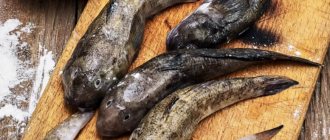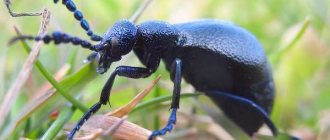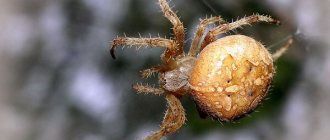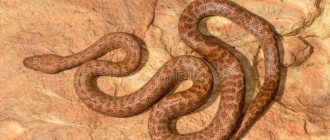Piranhas are dangerous and very voracious fish. Their existence is shrouded in all sorts of frightening myths and legends; they even appear as heroes of horror films. It is believed that even crocodiles avoid these bloodthirsty monsters. Piranha belongs to the characin genus. This is quite strange, since it also includes “peaceful” tetras, neons, and minors. They are similar to our cyprinids. However, piranhas have more than 50 species and most of them are not at all aggressive and feed on algae. The size of fish depends on their diet. So, herbivores grow up to a meter in length and weigh quite a bit, carnivores are usually no more than 30 cm.
Description and features
The standard body length is 15 cm, there are individuals up to 30 cm. The largest of the predatory piranhas reaches 60 cm. This is a large piranha. Maximum weight – 3.9 kg. The body is high, laterally flattened, dense, the muzzle is blunt. Females are larger, but males are brighter in color.
These hunters have large mouths equipped with pointed teeth. They have a triangular palisade shape, with very sharp edges. The lower ones are slightly larger than the upper ones. When the mouth is closed, they fit together, entering between the spaces and creating something like a “zipper.” The height of the teeth is from 2 to 5 mm.
The German scientist and naturalist Alfred Edmund Brehm attributed them to the genus of “sawtooths,” and for good reason. The teeth of a piranha are very similar to a saw. The lower jaw bone is pushed forward, the teeth are bent back.
It turns out that they seem to impale the victim’s flesh on themselves, preventing it from slipping out. The jaws are very powerful, their muscles are well developed. The special structure allows you to create high pressure when pressing even one of the jaws.
These devices work like a well-coordinated mechanism. First, they close and chop off pieces of meat, like a guillotine, then they move slightly and tear off the tougher veins. A mature individual can even bite through a bone. There are up to 77 teeth at the bottom, and up to 66 at the top. There are fish with a double row of teeth on the upper jaw - pennant or flag piranhas.
The tail is short but strong, there is almost no notch on it. All fins are of different sizes, longer on the back and near the anus, shorter on the belly. There is an adipose fin behind the dorsal fin. They are intricately colored; they can be silver, red, with a border, or with blue stripes; in young individuals they are often transparent.
The colors of these predators are generally varied and attractive. These fish are black, dark green, silver, with stripes, spots, shiny scales and rainbow transitions. With age, the color may change, spots may disappear, and fins may acquire a different color.
They navigate by sight and smell. Their eyes are large, their pupils are bottomless dark. Predators see well in water. The piranha in the photo has a slightly skeptical appearance due to its extended lower jaw. It looks like a bulldog, which is why it is called the “river dog.” It is even capable of making “barking” sounds when taken out of the water.
Cases of attack
In fact, piranhas should be more afraid of humans. And not vice versa. Research shows that piranhas are able to hide from people and keep their distance in their presence. However, it is worth saying that these fish have a really strong bite, one of the most powerful of its kind (in relation to body size). Piranhas can easily bite through not only a large layer of skin along with muscles, but their teeth can also easily dig into small human bones (in the area of a finger, for example).
As for attacks on people, it is impossible to give an exact figure. If only because piranhas do not eat humans. The fish can take a single bite. And then only for the purposes of self-defense. No one will report such episodes for obvious reasons.
Bull Sharks
Dangerous inhabitants of the Amazon can be encountered quite unexpectedly. For bull sharks, seawater is considered the natural habitat. However, they easily adapt to fresh water.
Cases have been recorded when these sharks climbed 4 km up the Amazon and ended up near the city of Iquitos in Peru.
The size of this predator can reach 3.3 m, and the weight of especially large individuals exceeds 300 kg. The bite force reaches almost 600 kg, and thanks to the sharp triangular teeth, these predators tear apart any prey in the blink of an eye.
This species attacks humans quite often and ranks 3rd in terms of aggressiveness and attacks after great white and tiger sharks.
The combination of all the above factors allows us to consider this species one of the most dangerous to humans. And considering that bull sharks often live close to populated areas, the risk to life and health in these areas increases many times over.
Brazilian or giant otter
The Brazilian otter lives in the Amazon rainforest and often encounters colonies of piranhas that live in the neighborhood. Typically, the giant otter chooses larger prey as food, for example, it hunts large fish, snakes, rodents, and sometimes destroys nests with bird eggs on land. These creatures hunt in groups, so it’s easier for them to herd fish or other prey into one flock, so that all members of the animal group remain well-fed.
A group of five or eight individuals sometimes descends into the water to hunt. If there are no particularly large fish nearby, then the otters begin their hunt for piranhas. The prey is driven to one place, after which they rush at it and tear it apart with teeth and claws. At the same time, otters can attack not only small individuals, but also large representatives of this species.
I took a bite myself - don’t bother anyone else
Red-bellied piranhas (considered the most dangerous) have a fairly high level of organization compared to many other fish. During the hunt, the school disperses to the sides and if someone finds food, he gives a sign to the others. After this, the flock gathers and begins to eat. After taking a bite, the fish swims to the side so that others can get closer to the food.
By the way, piranhas’ teeth do not wear down like those of dogs or cats. During an attack, they break off or simply fall out. But this does not make the fish less toothy - over the course of their entire life (about 20-25 years), piranhas lose and grow a couple of hundred sharp incisors. The teeth themselves are razor sharp, and when the mouth is closed they work like scissors, “cutting off” portioned pieces of meat or leaves.
As a result
It cannot be said that you can safely swim in a lake teeming with predatory fish. Most likely, they will not touch a person. But they will be able to bite a finger and crush a bone only because they will defend their territory and protect themselves from the attack of a much larger creature. By the way, most coastal restaurants cook this fish. Baked piranha is especially popular and can be enjoyed in Thailand. It is also worth recalling that many fans of exotic fish often keep piranhas in their aquarium at home.
Now that you know the answer to the question posed, you can safely swim in the ocean and not be afraid of being eaten by predatory and voracious piranhas.
Found a violation? Report content
Nutrition
Herbivorous piranhas feed on green plants, roots, plankton, and fruits that have fallen into the water. There are even piranhas that feed on scales - flag or pennant. And predatory individuals eat everything that moves. It is difficult to list who could become its victim.
These are fish, snakes, frogs, river and land animals, birds, insects, large reptiles and cattle. When hunting, piranhas use their strong qualities: speed, surprise of attack and mass character. They can lie in wait for the victim in a shelter, attacking from there at an opportune moment.
The whole flock attacks at once, and despite the joint forced march, they still act independently of one another. They have a rare sense of smell, which helps them find prey. If there is a wound on the body, there is no chance to hide from them.
Other fish, having found themselves in this powerful, rapidly attacking school, instantly lose their orientation and panic. Predators catch them one at a time, swallow the small ones immediately, and begin to gnaw the large ones together. The whole process happens very quickly, in a matter of minutes. They are omnivores, so they can attack not only fish, but also birds in the water.
Animals cannot escape from them if they end up in places where these fish accumulate. There have also been cases of attacks on people, especially in muddy water, or if they were injured. Even raising your bloody hand to the water is very dangerous; they are capable of jumping out of the water.
Their bloodthirstiness often suppresses their natural cowardice and caution. Sometimes they can even attack a crocodile if it is wounded. We observed how a crocodile fled from a school of piranhas by turning over with its belly up. His back is better protected than his soft belly. A whole flock of them can bring a large bull to exhaustion from loss of blood.
Travelers in the Amazon often observed clusters of these fish near their boats; they persistently accompanied them for a long time, hoping to profit. Sometimes they fought among themselves. Even the passage of insects or a fallen blade of grass caused them to violently rush at a moving object and create a landfill.
The fishermen watched as these fish ate their own wounded relatives. The caught fish, lying on the shore, somehow rolled back to the river, and in the blink of an eye was eaten by its fellow tribesmen.
At home, herbivorous piranhas are fed with greens: lettuce, cabbage, nettles, spinach, pureed vegetables, and sometimes fed with tubifex or bloodworms. Predators are fed fish, seafood, and meat. For example, they buy small, inexpensive guppies, swordtails, and sometimes even capelin.
Shrimp and squid are also favorably received by domestic piranha. And always have small pieces of meat in stock. Sometimes fish can be capricious, choosing one meat and rejecting another. If they eat poorly, then sound the alarm. Look at the temperature, water purity, aeration mode.
Undeservedly bad reputation
According to Carl Smallwood, author of Today I Learned, these fish don't have the prettiest smile. They might not even have a very nice demeanor. But they don't actually hunt humans. Herbert Axelrod (just a daredevil who loves to experiment), an expert on tropical fish, purposefully walked into a pool of piranhas wearing only his swimming trunks. Moreover, a piece of live meat was lowered on a hook in front of him. So the piranhas feasted on the fresh food and defiantly swam off into the sunset, leaving Herbert alone with his thoughts.
Based on this, we can conclude: piranhas are known for their predatory behavior and insatiable appetite. This means that they eat almost anything that comes their way. But there is one “but” that completely destroys the bad reputation of predators. Piranhas are incredibly shy and unsociable fish. They prefer to feed on carrion instead of attacking their prey. The only things they can hunt are small fish, worms and insects.
While the park employee was washing herself in the river, the elephant protected her (touching video)
With copper-brown veining and other fashionable shades of chestnut coloring
First I make a roll with Nutella, then they assemble a beautiful train: the children are delighted
In addition, piranhas do not form schools to attack other animals. They swim in schools because it is easier to protect themselves from other predators. They are far from the top of the food chain and are very often prey for other predatory fish and animals.
Arapaima
This is a giant predatory fish that lives in the Amazon and its tributaries. It is also called "puraruku" or "paiche".
Covered with thick scales, this fish is not afraid of piranhas.
She feeds on fish and poultry. The length of this fish can reach 2.7 m and weight 90 kg.
Due to its size, the arapaima must float to the surface to inhale air. The oxygen it receives through its gills is not enough. When floating to the surface, the fish makes a characteristic sound, similar to a loud cough.
Arapaima is so fierce that it even has teeth on its tongue.
Habitats
In the family of ray-finned fish there are 95 species, grouped into 16 genera. Some of them are dangerous and formidable predators, but there are also herbivorous individuals. Translated from the Guarani Indian language, the name “Piranha” is translated as “evil fish”. Due to the structure of the body and jaw, fish play the role of orderlies of the underwater environment, who get rid of sick and old individuals.
@ Kostudio — depositphotos.com
In nature, it lives in South America - in the Amazon River, the waters of Paraguay, Colombia, Argentina, Brazil. Due to careless human actions, they begin to reproduce in North America, as well as in Europe. There is information about the appearance of small populations in the waters of the Russian Federation.
Common piranhas
It’s hard to even imagine more terrible and ferocious creatures; this is the real quintessence of the horror of the Amazon River. We all know that the sharp teeth of these fish have more than once inspired Hollywood directors to create creepy films. However, in fairness, it is worth noting that piranhas are primarily scavengers. But, unfortunately, this does not mean that they do not attack healthy creatures. Their incredibly sharp teeth, located on the upper and lower jaws, meet very tightly, making them an ideal weapon for tearing flesh.
Dolphins
Another representative of the fauna that is dangerous for piranhas is the dolphin. This creature belongs to the order of cetaceans of the mammal family. As you know, dolphins have a very developed mind, they have their own system of sounds, and also move in a special way.
The main diet of dolphins is small fish that they come across, but piranhas sometimes become their prey. Like caimans, dolphins must ensure that the fish are already dead and cannot harm them from the inside.
Characteristic
Piranhas are famous for their jaws; photos of the fish will be shown when the jaw approaches; they are armed with very sharp teeth in the form of plates.
Such teeth can easily tear out a piece of meat, bite off a finger and even bite through steel. But this concerns wild fish.
Aquarium piranhas, like axolotls , are refined individuals, that is, not adapted to wild life, since they were bred in captivity.
The owner of the aquarium only with some caution reaches into the aquarium with his hands to clean it or fix the interior.
Important! Be careful! When working in an aquarium with piranhas, do not push them into a corner. Otherwise, the fish will have to attack and use its teeth. Therefore, you need to replant the fish during cleaning not with your hands, but with the help of a net.
Both wild and aquarium piranhas are cowardly fish.
First, out of shock, they turn over on their side and turn pale, pretending to be dead and sinking to the bottom.
Then, having recovered, they can attack, and then the one who disturbed them will be in trouble.
Piranhas reach only 20 cm in length (red-bellied piranhas can also be 33 cm long). The largest representative of the species seen in wild waters was 48 cm long
Caymans
Caimans are a species of reptile of the alligator genus. These creatures live next to piranhas, and very often these fish become their main diet.
Caimans are considered small alligators, they reach a length of only 1.5-2 meters, and their weight does not exceed 40 kg, with an average weight ranging from 6 to 10 kg. Predators prefer to spend most of their time basking in the sun on the muddy banks of rivers or streams that run through the jungle.
These animals hunt their prey in a special way: they look out for the prey for a long time, never rush when hunting, and at the right moment they capture food with a massive mouth with sharp teeth. Piranhas become prey to caiman when he starts hunting underwater. An important condition is that the piranha must already be dead before entering the esophagus, otherwise the fish may begin to attack its enemy from the inside. Therefore, caimans bite the fish harder to make sure that the food is safe.
Reproduction. Spawning
At the 10th month of life, the female is already able to lay eggs.
If piranhas are very large, then they can enter the period of maturity in the second, third, or even fifth year of life.
Piranhas go to spawn in spring and until mid-summer. Female fish lay their eggs on the bottom, mainly closer to the roots of plants, in the silt, digging holes.
There may be, it’s scary to think, 50,000 eggs at a time. The eggs are large and can reach a size of 4 mm.
After a week, the embryos are already feeding on themselves, passing water with microorganisms through themselves. And after two weeks the fry appear.
Parents, protecting their offspring, circle around all the time, driving away and eating enemies.
Interesting! The fry are initially herbivorous, feeding on plankton; as they grow older, they switch to zooplankton and then to small fish.
One piranha requires an aquarium with a volume of at least 100 liters. Accordingly, for four fish - from 300 liters or more. It is imperative to place any objects in the aquarium in which these fish can hide.
Predatory attacks
Now that the psychology of piranha behavior and the regularity of incidents involving them are clear, let's assume ideal conditions for predators to show aggression. That is, we will provoke an attack. All it takes is a drought and a few fish caught in a trap. Then we will send them to a separate pool and starve them for several days. Suddenly a bloody man appears, trips and falls face down into the lake. What will be next? Nothing. The tropical fish expert participated directly in this experiment at his own risk. And nothing happened. Several individuals (apparently these were more active males) simply swam up to the person, assessed the situation and swam away further.
To completely eat a person in five minutes, you need from 300 to 500 individuals. However, if the fish are not hungry, they will simply ignore the potential prey. Well, or wait until she dies a natural death.
Social structure and reproduction
Photo: School of piranhas
As it has already turned out, piranhas generally live in schools, sometimes very numerous. But the largest representative of their family (brown pacu) prefers complete solitude. Fish become sexually mature at around one and a half years. These fish are characterized by long-lasting paired love games before spawning. The color of excited individuals changes, becoming much brighter, and the aggressiveness of the fish during the mating season only intensifies.
Each fish couple in love has their own separate area, which they protect from the encroachments of others. Early in the morning, when the first rays of the sun appear, the female begins to spawn, turning over head down. At one time, a female can produce from 500 to 15,000 eggs, the amount depends on the type of fish. The eggs settle on aquatic plants, roots of coastal trees, and soil, and are immediately fertilized. Males diligently protect the clutches. The favorable temperature for the birth of fry is about 28 degrees plus.
The size of the eggs can reach up to 4 mm, their color is amber or greenish-yellow. The incubation period can last from two days to two weeks, it depends on the type and warmth of the water, the result of the whole action is the birth of larvae. For several days the larvae feed on the contents of the yolk sac left after birth, then they begin to swim on their own.
Even piranha fry are very voracious, insatiable and grow quickly. Caring parents continue their care until the fry begin to feed on their own. The lifespan of piranhas living in the wild is about twenty years, in captivity it is even slightly shorter.
Interesting fact: Among the piranhas, a long-liver has been recorded - the red pacu, who lived in captivity for 28 years.
Are piranhas dangerous for humans? Do piranhas eat people? Can a piranha eat a person?
ARE PIRANHAS DANGEROUS FOR HUMANS? From films and fiction books, we know that if you put your hand in the water where piranhas live, they will gnaw it off in a minute. Well, okay, maybe this is not accurate, but if there is some kind of wound on the body and blood gets into the water, then the piranhas can smell it a kilometer away and will definitely attack a person with the whole flock and certainly only a skeleton will be left of him.
Is this really true?
First you need to understand whether the piranha is really an extremely aggressive creature that attacks everything that moves in the water. This may sound unexpected, but piranha is a very cautious fish and does not pose any danger to humans. There is a large amount of evidence of people swimming in piranha-infested waters without any harm to their health.
This was fully demonstrated by Herbert Axeldorf, a famous biologist specializing in the study of tropical fish. To prove the safety of piranhas for humans, Herbert filled a small pool with piranhas and dived into it, leaving only his swimming trunks on. After swimming for some time among the predatory fish and without receiving any harm to his health, Herbert took fresh blood-soaked meat in his hand and continued to swim with it. But several dozen piranhas in the pool still did not approach the person, although quite recently they happily ate the same meat when there was no one in the pool.
Piranhas, considered fearsome predators with an insatiable thirst for fresh flesh, are actually rather timid fish and scavengers.
, not daring to approach large creatures.
It is known that piranhas prefer to stay in large schools, and if one piranha is seen in the water, there are always others nearby. But piranhas do this not because it is easier for a school of predatory fish to overwhelm and kill a person who enters the water, but because piranhas themselves are a link in the food chain for other larger species of fish. Being in a flock of dozens of individuals, the chance that you will be eaten is quite low.
Moreover, experiments with piranhas have shown that when alone, these fish do not feel as calm as if they were surrounded by other fish.
But despite their peaceful behavior towards humans, piranhas are real killing machines for other fish species that are lower than them in the food chain. Their powerful jaws are designed to bite and tear, and their dense, muscular bodies are capable of incredibly fast movements and jerks underwater. The piranha's jaw muscle contraction force relative to body size is believed to be the highest of any other vertebrate in the world. For example, the common piranha can easily bite off the finger of an adult. https://www.youtube.com/watch?v=KuSRisDMZ90
But in history there has not been a single reliable case of a fatal attack by piranhas on a person. But this does not mean at all that these fish never bite a person or an animal that enters the water. And this behavior is almost always caused not by the aggressive behavior of the fish, but by self-defense or abnormal weather conditions, because of which the behavior of the piranhas begins to differ sharply from usual. Abnormal weather conditions mean a period of drought, when the rivers in which piranhas live dry up, and many fish remain in depressions filled with water, but cut off from the main channel, deprived of food. Starving predators gradually begin to eat themselves and may well rush at any creature that comes close to the water. Sometimes the tendency of piranhas to behave aggressively is recorded during the spawning period, when they rush at a person or animal in self-defense, but such cases are extremely rare. And of course there is no talk of a collective attack by piranhas on humans.
Surprisingly, piranhas, being, according to many, one of the most dangerous predators, are at the same time unusually timid! It is advisable to keep the aquarium in which piranhas live away from sources of noise and shadows, otherwise your pets will constantly be on the verge of fainting! It is a well-known fact among aquarists that a click on the glass or a sudden movement near the aquarium is enough for piranhas to faint. They also often faint during transportation from the place of purchase to their future home.
But all of the above does not mean that piranhas will refuse to eat human flesh. Unfortunately, sometimes tragic incidents occur on the water - people or animals drown. An already lifeless body floating in the water attracts many fish, including piranhas, which leave specific bites on it. People who see this think that the cause of death was an attack by piranhas - this is how most myths about attacks by flocks of piranhas on people or animals are born.
And here's Pacu - the common name for several species of omnivorous South American freshwater piranhas. The pacu and the common piranha (Pygocentrus) have the same number of teeth, although differences in their alignment are noted; The piranha has pointed, razor-shaped teeth with a pronounced mesial bite (the lower jaw protrudes forward), while the pacu has square, straight teeth with a slight mesial or even distal bite (the upper front teeth are pushed forward in relation to the lower ones). As adults, wild pacu weigh more than 30 kg and are much larger than piranhas.
From films and fiction books, we know that if you put your hand in the water where piranhas live, they will gnaw it off in a minute. Well, okay, maybe this is not accurate, but if there is some kind of wound on the body and blood gets into the water, then the piranhas can smell it a kilometer away and will definitely attack a person with the whole flock and certainly only a skeleton will be left of him.
Is this really true?
First you need to understand whether the piranha is really an extremely aggressive creature that attacks everything that moves in the water. This may sound unexpected, but piranha is a very cautious fish and does not pose any danger to humans. There is a large amount of evidence of people swimming in piranha-infested waters without any harm to their health.
This was fully demonstrated by Herbert Axeldorf, a famous biologist specializing in the study of tropical fish. To prove the safety of piranhas for humans, Herbert filled a small pool with piranhas and dived into it, leaving only his swimming trunks on. After swimming for some time among the predatory fish and without receiving any harm to his health, Herbert took fresh blood-soaked meat in his hand and continued to swim with it. But several dozen piranhas in the pool still did not approach the person, although quite recently they happily ate the same meat when there was no one in the pool.
Piranhas, considered fearsome predators with an insatiable thirst for fresh flesh, are actually rather timid fish and scavengers.
, not daring to approach large creatures.
It is known that piranhas prefer to stay in large schools, and if one piranha is seen in the water, there are always others nearby. But piranhas do this not because it is easier for a school of predatory fish to overwhelm and kill a person who enters the water, but because piranhas themselves are a link in the food chain for other larger species of fish. Being in a flock of dozens of individuals, the chance that you will be eaten is quite low.
Moreover, experiments with piranhas have shown that when alone, these fish do not feel as calm as if they were surrounded by other fish.
But despite their peaceful behavior towards humans, piranhas are real killing machines for other fish species that are lower than them in the food chain. Their powerful jaws are designed to bite and tear, and their dense, muscular bodies are capable of incredibly fast movements and jerks underwater. The piranha's jaw muscle contraction force relative to body size is believed to be the highest of any other vertebrate in the world. For example, the common piranha can easily bite off the finger of an adult.
But in history there has not been a single reliable case of a fatal attack by piranhas on a person. But this does not mean at all that these fish never bite a person or an animal that enters the water. And this behavior is almost always caused not by the aggressive behavior of the fish, but by self-defense or abnormal weather conditions, because of which the behavior of the piranhas begins to differ sharply from usual. Abnormal weather conditions mean a period of drought, when the rivers in which piranhas live dry up, and many fish remain in depressions filled with water, but cut off from the main channel, deprived of food. Starving predators gradually begin to eat themselves and may well rush at any creature that comes close to the water. Sometimes the tendency of piranhas to behave aggressively is recorded during the spawning period, when they rush at a person or animal in self-defense, but such cases are extremely rare. And of course there is no talk of a collective attack by piranhas on humans.
Surprisingly, piranhas, being, according to many, one of the most dangerous predators, are at the same time unusually timid! It is advisable to keep the aquarium in which piranhas live away from sources of noise and shadows, otherwise your pets will constantly be on the verge of fainting! It is a well-known fact among aquarists that a click on the glass or a sudden movement near the aquarium is enough for piranhas to faint. They also often faint during transportation from the place of purchase to their future home.
But all of the above does not mean that piranhas will refuse to eat human flesh. Unfortunately, sometimes tragic incidents occur on the water - people or animals drown. An already lifeless body floating in the water attracts many fish, including piranhas, which leave specific bites on it. People who see this think that the cause of death was an attack by piranhas - this is how most myths about attacks by flocks of piranhas on people or animals are born.
And here's Pacu - the common name for several species of omnivorous South American freshwater piranhas. The pacu and the common piranha (Pygocentrus) have the same number of teeth, although differences in their alignment are noted; The piranha has pointed, razor-shaped teeth with a pronounced mesial bite (the lower jaw protrudes forward), while the pacu has square, straight teeth with a slight mesial or even distal bite (the upper front teeth are pushed forward in relation to the lower ones). As adults, wild pacu weigh more than 30 kg and are much larger than piranhas.
here's more about them -
We all grew up hearing stories about piranhas that could rip the skin off your bones. Can piranhas kill you? Certainly. It turns out that if piranhas are very hungry, they can easily eat a person.
Given their size, piranhas are considered the most powerful predators on the planet. Since they always travel in schools, you will never meet just one piranha - you will meet dozens, or even hundreds of such fish.
So what happens when you get attacked by piranhas? Unfortunately, no one survived after meeting them, so we don’t know what it’s like?
Piranhas rip the flesh from your bones
Piranhas can gnaw a person to the bone. This happened in 2015 to a 6-year-old girl from Brazil who fell into water with piranhas. When they pulled her out of the waters, they discovered that the fish had almost completely torn off all the flesh from the child’s legs.
You might bleed to death
Piranhas are too small to completely eat a person. However, their numerous bites are already enough for a person to die from loss of blood.
Piranhas prefer to attack the face first
Piranhas instinctively grab their prey by the face, which is truly scary. They often attack animals that come to a pond to drink water. As soon as the animal tilts its head, the piranha sinks its teeth into it.
Piranhas scream at you while they feast!
The fact that piranhas can bite you is already scary, however, unlike other fish, piranhas can also scream. They can make three different sounds depending on the situation. So, when you are surrounded by piranhas tearing off your skin, you will hear not only your screams, but also theirs.
Piranha has a very painful bite
It is believed that the piranha bite is the most painful. Therefore, at the first bite there is a high probability that you will lose consciousness. What can we say about the bites of hundreds of such fish.
Piranhas eat everything
One day, an 11-year-old boy, vacationing with his family in Peru, fell into water infested with piranhas. When his body was found, it was discovered that the piranhas had eaten not only his flesh, but also his internal organs. It is assumed that piranhas are more likely to attack victims who cannot fight back.
You will be eaten in a frenzy
Piranhas always swim in schools, so you will be attacked en masse. Scientists say that when piranhas don't have enough food or are squeezed into a small space, they start acting crazy, which isn't good for those around them.
They take small bites
Piranhas bite off small pieces from their victims, however, their bites are quite deep. Therefore, the victim loses consciousness from pain, and then dies due to blood loss as a result of numerous bites.
The more you suffer, the more they bite
Piranhas can taste just a drop of blood dissolved in 200 liters of water. It is the smell of blood that attracts them. Therefore, after the attack begins, more and more fish are attracted to the victim.
They cling tightly
Piranhas grab onto the flesh of their prey very tightly. While one man from China was washing his dog in the river, a piranha grabbed his hand. He was able to tear it off with difficulty, and then kept it at home as a pet.
They are not afraid of human activity
Do you think that if 70 people swim in the Amazon, piranhas will not be able to attack you? Not so. When more than 70 people swam to escape the heat in Argentina in 2013, they were all left with piranha bites on their legs and arms.
Popular films frighten the public with the image of a bloody school of fish, bringing death and devouring people not even in dozens, but in hundreds. Meanwhile, there is not a single fact of human death from the teeth of piranhas! Yes, there were bites. Most often, when curious people stuck their fingers into the aquarium. But to dub the unfortunate fish cannibals is already too much.
Many scientists who have been living on the shores of the Amazon for decades and studying its flora and fauna confirm that during their entire stay they have never seen a person seriously injured by piranhas.
Piranhas attack in a flock. Piranhas attack only in a pack, no, this is not so, in fact, the same scientists have proven that piranhas organize groups solely for the purpose of protection!
These small fish often suffer from attacks from large predators, so instinct forced them to unite with their brothers in order to fight back and survive.
Piranhas are crazy about fresh blood, and hunt any creature that carelessly ends up in the river
Yes, the smell of blood makes these fish excited. As, indeed, any predator in wildlife. Try waving your bloody hand in front of a lion's nose - the animal is unlikely to remain unperturbed. Even peaceful cows become violent at the sight and smell of blood. However, this trait is commonly attributed to piranhas. Attacks on people and livestock are a different story.
Expert opinion
By nature, piranhas are orderlies who perform a noble function and rid the waters of the Amazon of carrion. These fish feed on dead and dying animals, and never attack anyone who can fight back.
In hungry years, there were cases when piranhas, out of desperation, could even hunt sleeping crocodiles and their own relatives. But what wild animal, especially a predator, would act differently?
Where did the legend come from?
Do piranhas eat people? Of course not, this is another myth invented by man. The culprit behind the piranha's creepy reputation was Theodore Roosevelt. When the president was traveling through the Amazon, the locals decided to shock him with a brutal performance. They collected hundreds of piranhas and kept them without food for several days, and then, in the presence of Roosevelt, they drove a cow into the water with the fish, mad with hunger. Naturally, almost nothing remained of that one in a matter of minutes. And the president told the whole world about the bloodthirstiness of “these creatures.” People carried out a cruel experiment for their own amusement, and managed to blame it on innocent creatures. That’s the whole “terrible” secret of piranhas.
How dangerous are piranhas?
These fish have long had a bad reputation. It is considered to be rightful. They are eager to kill and greedy for blood. Their appetite is insatiable; a school of piranhas quickly gnaws at the carcass of a pig or sheep, deftly tearing the meat from the bones.
However, not all types of piranha are so scary. Some of them are harmless. How can you find out what awaits in the muddy water of the river? Indians have their own signs.
The victim had no chance. As soon as the trout and the pool where the piranhas were splashing were released, flocks of enemies rushed at it. Not even a second had passed before one of the fish plucked a whole piece from the side of the trout. This was the signal. Incited by the hunting instinct, six other piranhas began to tear new pieces out of the trout's body.
Her stomach was already torn to pieces. She jerked, trying to dodge, but another squad of killers - there were now about twenty of them - grabbed the fugitive. A cloud of blood mixed with scraps of entrails spread in the water. The trout were no longer visible, and the angry predators were still scurrying about in the muddy water, poking their noses and the invisible outline of the fish.
Suddenly, after about half a minute, the darkness passed. The piranhas have calmed down. The thirst to kill subsided. Their movements slowed. There was no trace left of the trout, a fish 30 cm long.
Common piranha (Pygocentrus nattereri)
Classics of the genre: vampire and piranha
If you have ever seen a piranha hunt in a movie, you will never forget this nightmarish scene. At the mere sight of it, ancient fears are resurrected in a person’s soul. Scraps of old legends swirl in my memory: “It happened on the Rio Negro. Or on Rio San Francisco, Xinga, Araguaia... My father fell into the water..."
From Alfred Brehm to Igor Akimushkin, books about animals are replete with stories about bloodthirsty piranhas. “Very often a crocodile takes flight in front of a wild school of these fish... Often these fish overpower even a bull or tapir... Dobritzhofer says that two Spanish soldiers... were attacked and torn to pieces” (A Brehm). These messages have become “classics of the genre.” Every high school student now knew that the rivers of Brazil were teeming with killer fish.
Over time, schools of fish swam from books and articles into cinema halls. Among the horror films made about Amazonian predators, we can mention the films “Piranha” (1978) directed by Joe Dante and “Piranha 2” (1981) directed by James Cameron.
Their plots are similar. There is a military base on the shore of a picturesque lake. Piranhas are grown there. By chance, predators fall into the waters of the lake and begin to eat tourists. And in general, the same “Jaws”, only smaller in size and more in number.
Her name alone makes fans of these films shiver. And it is unlikely that any connoisseur of creepy stories, once in Brazil, will risk going into the waters of the river if they find out that piranhas are found there.
The first reports about them began to arrive when the conquistadors reached Brazil and went deep into the wilds of the forests. These messages made my blood run cold.
“The Indians, wounded by cannonballs and musket bullets, fell screaming from their canoes into the river, and ferocious piranhas gnawed them to the bones,” wrote a certain Spanish monk who accompanied the gold and adventure seeker Gonzalo Pizarro in 1553 during a predatory campaign and the lower reaches of the river. Amazons. (Horrified by the cruelty of the fish, the pious monk did not think that the Spaniards, who fired cannons at the Indians, were no more merciful than piranhas.)
Since then, the reputation of these fish has been justifiably fearsome. They smelled the smell of blood better than sharks. Here is what the German traveler Karl-Ferdinand Appun wrote in 1859 when he visited Guyana: “Intending to take a bath, I had just immersed my body in the warm waters of the river, when I jumped out headlong and retreated to the shore, because I felt a piranha bite on my thigh - just where there was a wound from a mosquito bite, scratched by me until it bled.”
Reading such confessions, at some point you catch yourself thinking that piranhas are fiends of hell, who escaped from there through an oversight and are now tyrannizing people and animals. There are no more terrible creatures in the world than them. An awkward step into the water - and dozens of razor-sharp teeth dig into your leg. Good God! One skeleton remains... Is all this really true?
Golden mean: flooded forest and great dry land
“It would be naive to demonize piranhas,” writes German zoologist Wolfgang Schulte, author of the recently published book Piranhas. For about 30 years he studied these tropical predators and, like no one else, knows their two-faced essence: “But it would also be naive to portray them as harmless fish, not at all dangerous to humans. The truth lies in the middle."
Over 30 species of piranha live in South America. They feed mainly on small fish, shrimp, carrion and insects.
Only a few piranhas attack warm-blooded animals: among them, for example, red and black piranhas. But these fish are quick to kill. If a young heron, having fallen out of the nest, awkwardly plops into the water, “she is surrounded by a flock of piranhas,” writes V. Schulte, “and seconds later only feathers float on the water.”
Piranhas have lunch in an aquarium
He had seen similar scenes himself, although it is not easy to thoroughly understand river battles. Even experts have difficulty distinguishing between individual types of piranhas, since the color of the fish changes dramatically with age.
However, the most aggressive piranhas usually feed only on carrion. “They rarely attack living mammals or people. As a rule, this happens during the dry season, when the habitat of fish is sharply narrowed and there is not enough prey. They also attack individuals with bleeding wounds,” explains Schulte. If the attack is successful and blood spurts out from the victim, all the piranhas scurrying nearby rush to her.
So, the aggressiveness of piranhas depends on the time of year. During the rainy season, the Amazon and Orinoco flood. The water level in them rises by about 15 meters. Rivers flood a vast area. Where the forest recently grew, boats float, and the rower, lowering a pole into the water, can reach the crown of the tree. Where the birds sang, the fish are silent.
Flooded forests become a breadbasket for piranhas. They have a great selection of food. The local Indians know this and, fearing nothing, climb into the water. Even children splash in the river, dispersing schools of piranhas.
Piranhas have sharp teeth
Indian children swim in the Orinoco River, infested with piranhas
Water skiers carelessly ride along the Orinoco fairway, teeming with “killer fish.” Guides carrying tourists on boats without hesitation jump into the water, and right under their feet tourists catch piranhas with fishing rods.
Miracles and nothing more! Predators behave more modestly than trained lions. It’s just that circus lions sometimes develop an appetite.
Piranhas change their character when there is great dryness. Then the rivers turn into streams. Their level drops sharply. Everywhere you can see “lagoons” - lakes and even puddles in which fish, caimans and river dolphins splash, which have become captives. Piranhas, cut off from the river, do not have enough food - they fuss and rush about.
Now they are ready to bite anything that moves. Any living creature that gets into their pond is immediately attacked. As soon as a cow or horse puts its face into the lake to drink, angry fish grab its lips and tear out the meat in pieces. Often piranhas even kill each other.
“During a drought, not a single local resident would risk swimming in such a reservoir,” writes Wolfgang Schulte.
Skeleton in the waves of memory: fisherman and river
Harald Schultz, one of the best experts on the Amazon, wrote that during his 20 years in South America, he knew only seven people who were bitten by piranhas, and only one was seriously injured. It was Schultz, who lived among the Indians for a long time, who came up with a joke at one time, ridiculing the fears of Europeans, for whom death hides at every turn in the Amazon forests.
Until now, this anecdote wanders from one publication to another, often taken on faith.
“My father was about 15 years old at the time. The Indians were chasing him, and he, running away from them, jumped into a canoe, but the boat was flimsy. She capsized and he had to swim. He jumped out onto the shore, but bad luck: he looked, but only a skeleton was left of him. But nothing else terrible happened to him.”
Most often, the victims of piranhas are fishermen, who hunt them themselves. After all, in Brazil, piranhas are considered a delicacy. Catching them is easy: you just need to throw a hook tied to a wire into the water (the piranha will bite through ordinary fishing line), and twitch it, imitating the fluttering of the victim.
A fish the size of a palm hangs on a hook right there. If a fisherman attacks a school of piranhas, then just know that you have time to throw the hook: every minute you can pull out a fish.
In the excitement of the hunt, it’s easy to turn into a victim yourself. A piranha thrown out of the water wriggles wildly and grabs the air with its teeth. Taking it off the hook can cause you to lose a finger. Even seemingly dead piranhas are dangerous: the fish seems to have stopped moving, but if you touch its teeth, its mouth will reflexively tighten, like a trap.
Red pacu (Piaractus brachypomus) herbivorous piranha
How many adventurers who reached the shores of the Amazon or its tributaries lost their fingers in the old days only because they decided to catch fish for their dinner. This is how legends were born.
Indeed, what does a piranha opponent look like at first glance? The fish seems inconspicuous and even dull. Her weapon is “sheathed,” but as soon as she opens her mouth, the impression changes. The piranha's mouth is lined with triangular, razor-sharp teeth that resemble daggers. They are positioned so that they snap together like a zipper on your clothing.
The hunting style inherent in piranhas is also unusual (by the way, sharks behave similarly): having stumbled upon a prey, it instantly rushes at it and cuts off a piece of meat; Having swallowed it, it immediately digs into the body again. In a similar way, the piranha attacks any prey.
Piranha species Metynnis luna Soret
Flag piranha (Catoprion mento)
However, sometimes the piranha itself ends up in someone else's mouth. In the rivers of America it has many enemies: large predatory fish, caimans, herons, river dolphins and freshwater matamata turtles, which are also dangerous to humans. All of them, before swallowing a piranha, try to bite it as hard as possible to check whether it is still alive.
“Swallowing a live piranha is like putting a running circular saw into your stomach,” notes American journalist Roy Sasser. The piranha is not the prophet Jonah, ready to rest patiently in the belly of the whale: it begins to bite and can kill the predator that caught it.
As already mentioned, the piranha has a superbly developed sense of smell - it smells blood in the water from afar. As soon as you throw bloody bait into the water, piranhas swim from all over the river. However, we must not forget that the inhabitants of the Amazon and its tributaries can only rely on their sense of smell. The water in these rivers is so muddy that you can’t see anything ten centimeters away. All that remains is to sniff or listen for prey. The sharper the sense of smell, the higher the chances of survival.
Piranha's hearing is also excellent. The wounded fish flounder desperately, generating high frequency waves. Piranhas catch them and swim to the source of this sound.
However, piranhas cannot be called “voracious killers,” as was long believed. English zoologist Richard Fox placed 25 goldfish in a pool where two piranhas were swimming. He expected that the predators would soon kill all the victims, like wolves entering a sheepfold.
However, the piranhas killed only one goldfish per day between them, dividing it in half like brothers. They did not deal with their victims in vain, but killed only to eat.
However, they also did not want to miss out on rich prey - a flock of golden fish. Therefore, on the very first day, the piranhas bit off their fins. Now the helpless fish, unable to swim on their own, swayed in the water like floats - tail up, head down. They were a living food supply for the hunters. Day after day, they chose a new victim and, without haste, ate it.
Amazonian “wolves” are friends of the Indians
In their homeland, these predators are real river orderlies (remember that wolves are also called forest orderlies). When rivers overflow during the rainy season and entire areas of forest are hidden under water, many animals do not have time to escape. Thousands of corpses roll on the waves, threatening to poison all living things around with their poison and cause an epidemic. If it were not for the agility of the piranhas, which eat these carcasses white to the bone, then people would die from seasonal epidemics in Brazil.
And not only seasonal ones! Twice a month, on the new moon and full moon, a particularly strong (“spring”) tide begins: the waters of the Atlantic rush deep into the continent, rushing up the river beds. The Amazon begins to flow backwards, spilling over its banks.
If you consider that every second the Amazon dumps up to 200 thousand cubic meters of water into the ocean, you can easily imagine what a wall of water is rolling backwards. The river overflows for kilometers.
The consequences of these regular floods are felt even 700 kilometers from the mouth of the Amazon. Small animals die from them again and again. Piranhas, like kites, clear the entire area of carrion, which would otherwise rot for a long time in the water. In addition, piranhas exterminate wounded and sick animals, healing the populations of their victims.
The pacu fish, a close relative of the piranha, is completely vegetarian - it is not a forest orderly, but a real forester. With its powerful jaws, it crushes nuts, helping their kernels to spill into the soil. Swimming through the flooded forest, she eats fruits, and then, far from the place of her meal, she spews out seeds, dispersing them, as birds do.
Learning the habits of piranhas, one can only remember with bitterness that at one time the authorities of Brazil, falling under the terrible spell of legends, tried to put an end to these fish once and for all and poisoned them with various poisons, simultaneously exterminating other inhabitants of the rivers.
Well, in the 20th century, man experienced the “dizziness of progress.” Without any hesitation, we tried to establish balance in nature in our own way, destroying natural mechanisms and suffering the consequences every time.
The natives of South America have long learned to get along with piranhas and even made them their helpers. Many Indian tribes living along the banks of the Amazon do not bother digging graves to bury their relatives during the rainy season. They lower the dead body into the water, and the piranhas, born gravediggers, will leave a little of the deceased.
The Guarani Indians wrap the deceased in a net with large mesh and hang it over the side of the boat, waiting until the fish scrape off all the flesh. Then they decorate the skeleton with feathers and hide (“bury”) with honor in one of the huts.
Black-sided piranha (Serrasalmus humeralis)
Since time immemorial, piranha jaws have replaced scissors for Indians. When making arrows poisoned with curare poison, the Indians cut their tips with the teeth of piranhas. In the wound of the victim, such an arrow broke off, all the more likely to poison it.
There are many legends about piranhas. Villages and rivers in Brazil are named after them. In the cities, “piranhas” are the name given to girls of easy virtue who are ready to rob their prey completely.
Nowadays, piranhas have also begun to be found in the reservoirs of Europe and America. I remember that some tabloid newspapers reported about the appearance of “killer fish” in the Moscow region. It's all about exotic lovers who, having got unusual fish, can, fed up with the “toy”, throw them straight into a neighboring pond or sewer drain.
However, there is no need to panic. The fate of piranhas in our climate is unenviable. These heat-loving animals quickly begin to get sick and die, and they will not survive the winter in open waters. And they don’t look like serial killers, as we have seen.
If you want to post this article on your website or blog, this is permitted only if there is an active and indexed backlink to the source.











